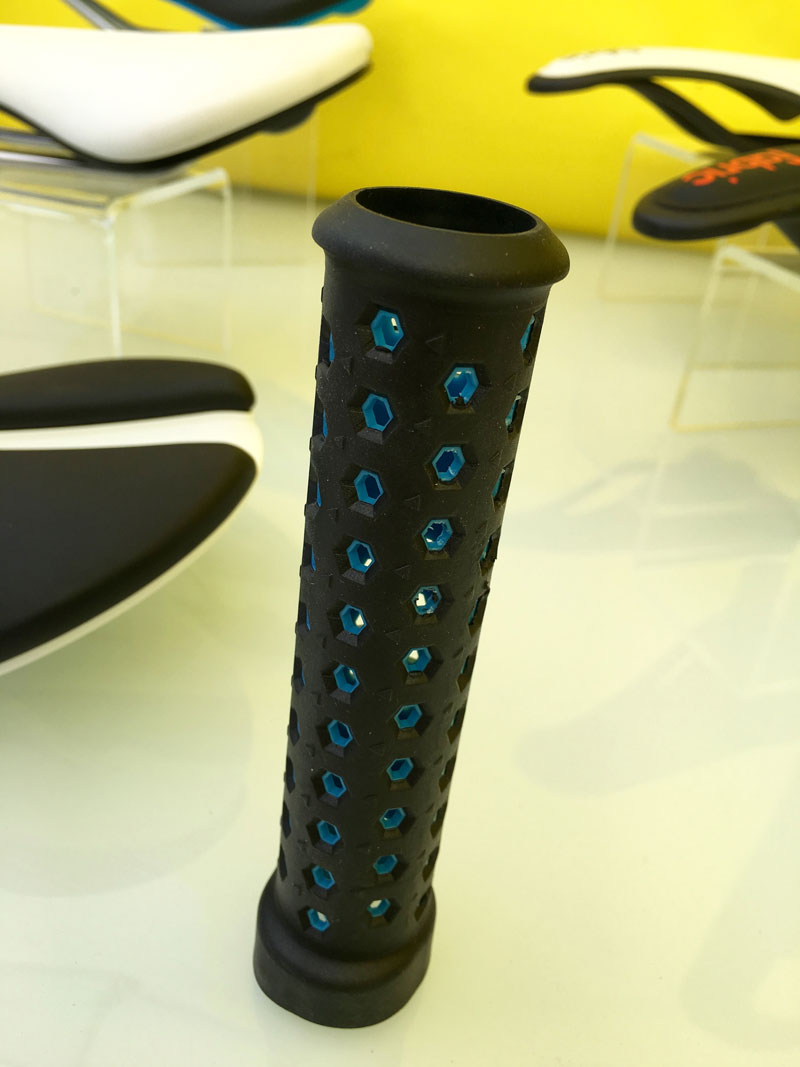How To Put On Foam Bike Grips

Mountain bike grips are a seemingly unproblematic item, ane that many riders tend to overlook. Simply mountain bike grips serve iii important functions that should notbe disregarded:
- Provide a not-slip surface for handlebars
- Create a comfortable interface for the rider
- Protect bar ends
For riders experiencing issues with sore easily, or for those who are wondering what else is out there beyond stock grips, this guide volition explain how to find the best mountain cycle grips for y'all.
Grips Are for Gripping
Manifestly grips are for gripping, ensuring that easily stay firmly attached to handlebars fifty-fifty when the bike gets wet from sweat or rain. Near grips employ safety or a rubber-like material, only grips with foam, leather, and fifty-fifty cork surfaces are available. Synthetic materials generally manage moisture by repelling information technology, while natural materials and foam tend to absorb moisture.

Rubber and rubber-like grips tin can offer varying degrees of stickiness or "softness," which is not to be dislocated with padding. Softer rubber surfaces tend to grip meliorate, even without gloves, but volition wear out more than chop-chop than a harder, less sticky rubber.
Some grips feature knobby patterns along the surface, while others are completely smooth. These patterns are designed with both no-slip functioning and comfort in mind. While a bike grip that appears very knobby might seem to offer better no-slip performance, keep in mind that a smooth grip with sticky rubber might perform merely likewise.
Over fourth dimension, all mountain bike grips tend to lose their gripping power as the surface is worn away. On cycle grips with a design, information technology'southward piece of cake to spot smooth parts where the surface has been worn away. This offers a good indication of when it is time to supplant the grip.
Grips Are for Condolement
Gripping a bare mountain bicycle handlebar through rough singletrack would exist painful indeed! Mountain bike grips are designed to provide padding and vibration damping to keep hands comfortable, even on extremely long or bumpy rides. Manus position is as well a consideration in grip blueprint: a skilful grip minimizes the potential for hand cramps.
Various levels of padding are available in mount bike grips, and over again, there are many different materials to choose from, each with their own unique backdrop. Some riders prefer the feel of a gel grip, while others similar cork or leather.

Hands come in various shapes and sizes, and fortunately so practise bike grips. Outer grip diameters range from about 27mm up to 35mm. Riders with larger hands should choose grips with a larger diameter, while riders with smaller easily should go with a smaller grip. If a grip is too big, it can lead to hand slippage and control issues. If a grip is too small, information technology could result in increased pain, particularly in the palm.

Not all mountain bike grips are perfectly round. In fact, many are tapered from left to right and/or around the circumference. Ergonomic grips offer a flatter, wider surface on the outside of the grip and taper back to a more circular shape at the pollex. An ovalized grip contour offers a balance between a full-on ergonomic grip and a perfectly round one. For riders who are experiencing discomfort in the easily or even shoulders, a specially-shaped mountain cycle grip might be a skillful choice.
Other Considerations
There are two basic ways bike grips tin be attached to a fix of handlebars: friction or lock rings. Friction grips are simply slid (or more than often, forced) onto the bars and are held in place past friction betwixt the inside of the grip and the handlebar. These grips are never fully secured, and therefore tend to rotate in wet conditions or when the rider places a lot of torque on them.
Lock-on grips are very pop with mount bikers considering they eliminate the twisting associated with friction grips. The grips are secured to the confined with either a single clench on one stop of the grip or more often, clamps on both ends of the grips. A bolt is used to tighten and release the clench, generally making them easier to install and remove than friction grips.

Mount bicycle grips are available in various lengths too. Riders won't observe a big variation in lengths: most grips autumn between 130mm and 140mm in length. Even so, shorter 90mm grips are designed to work with grip shift systems. Riders with smaller hands simply go out more of the grip unused, though if bar infinite is at a premium a shorter grip may be in gild.
Bated from grip and condolement, grips also serve to protect handlebar ends. Bikes are constantly beingness laid down on their sides, and close calls with trees and rocks can grind away at bar ends. Look for grips with thick, solid end caps to protect bars, specially carbon confined which are particularly susceptible to damage.

Grip weights can vary pretty wildly, depending on the corporeality of padding, clench configuration, and the ergonomic profile. The lightest grips are mostly friction-style cream grips, while lock-on ergonomic grips tin add significant weight.
Pricing for mount wheel grips generally falls in a pretty tight range, with inexpensive friction grips bachelor for less than $x for a pair and ergonomic grips topping out around $60. Leather grips tin can sell for even more.
Finally, mountain cycle grips should not exist disregarded as an artery for making a statement. Most companies offer several color choices for their nigh popular grips, and various clamp finishes, surface patterns, and profiles go far possible to truly customize a bicycle build.
Mount bike grips serve 3 important functions: command, comfort, and protection. With dozens of designs on the market today, it's easy to find a quality mount bike grip that does all iii for a reasonable price.
Source: https://www.singletracks.com/mtb-gear/hands-sore-bike-grips-buyers-guide/
Posted by: purcellbrinelition.blogspot.com


0 Response to "How To Put On Foam Bike Grips"
Post a Comment